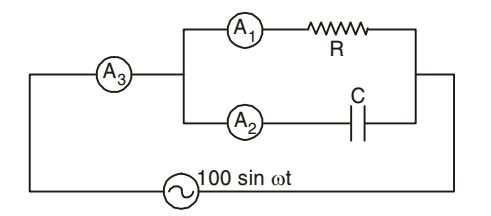Electric circuits miscellaneous
- In the series Rc circuit shown in the figure, the voltage across C starts increasing when the d.c. source is switched on. The rate of increase of voltage across C at the instant just after the switch is closed (i.e. at t = 0+) will be

-
View Hint View Answer Discuss in Forum
Voltage across the capacitor at any time t, Vc = V (l – e– t / RC)
= l – e– t / RC ... (since V = 1 volt)∴ dVc = 1 e– t / RC dt RC At t = 0+ , dVc = 1 dt RC
Correct Option: D
Voltage across the capacitor at any time t, Vc = V (l – e– t / RC)
= l – e– t / RC ... (since V = 1 volt)∴ dVc = 1 e– t / RC dt RC At t = 0+ , dVc = 1 dt RC
- A periodic rectangular signal X(t) has the wave form shown in the figure. Frequency of the fifth harmonic of its spectrum is

-
View Hint View Answer Discuss in Forum
Periodic time = 4 ms = 4 × 10 – 3 sec.
Fundamental frequency = 103 = 250 Hz 4
∴ Frequency of the 5th harmonic = 250 × 5 = 1250 Hz
Correct Option: D
Periodic time = 4 ms = 4 × 10 – 3 sec.
Fundamental frequency = 103 = 250 Hz 4
∴ Frequency of the 5th harmonic = 250 × 5 = 1250 Hz
- In the given figure, A1, A2 and A3 are ideal ammeters. If A1 reads 5A, A2 reads 12 A, then A3 should read

-
View Hint View Answer Discuss in Forum
Since the source is an a.c voltage, therefore
I 3rms = √I1rms ² + I2rms ²
= √5² +12² = 13 ACorrect Option: C
Since the source is an a.c voltage, therefore
I 3rms = √I1rms ² + I2rms ²
= √5² +12² = 13 A
- The voltage VC1, VC2 and VC3 across the capacitors in the circuit in the given figure, under steady state are respectively

-
View Hint View Answer Discuss in Forum
In steady state, capacitors are open and inductances are short.

For VC1VC1 = 100 × 40 = 80 V 50
For VC2 and VC3VC2 = 80 × C3 C2 + C3 = 80 × 3 = 48 V 5 VC3 = 80 × C2 C2 + C3
= 16 × 2 = 32 V
Correct Option: B
In steady state, capacitors are open and inductances are short.

For VC1VC1 = 100 × 40 = 80 V 50
For VC2 and VC3VC2 = 80 × C3 C2 + C3 = 80 × 3 = 48 V 5 VC3 = 80 × C2 C2 + C3
= 16 × 2 = 32 V
- When the angular frequency ω in the given figure is varied from 0 to ∞ , the locus of the current phasor I2 is given by

-
View Hint View Answer Discuss in Forum
I2(ω) = Em cosωt R2 + 1 jωC 

At ω = ∞ , I2ω = Em R2
Also, I2 is leading with voltage phasor.
At ω = 0, I2 (0) = 0
Thus desired locus should be as shown.Correct Option: A
I2(ω) = Em cosωt R2 + 1 jωC 

At ω = ∞ , I2ω = Em R2
Also, I2 is leading with voltage phasor.
At ω = 0, I2 (0) = 0
Thus desired locus should be as shown.

